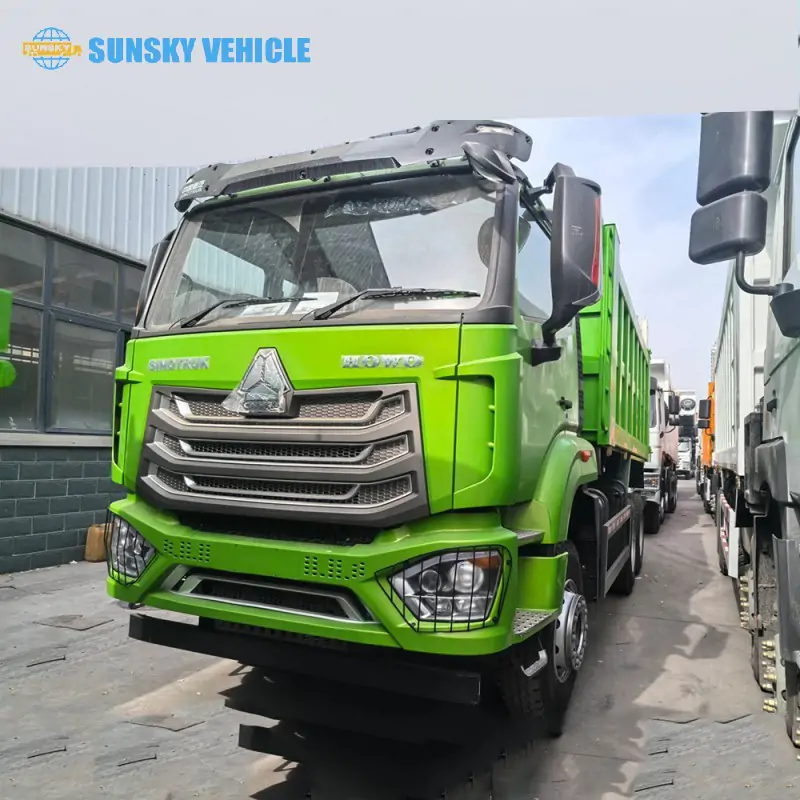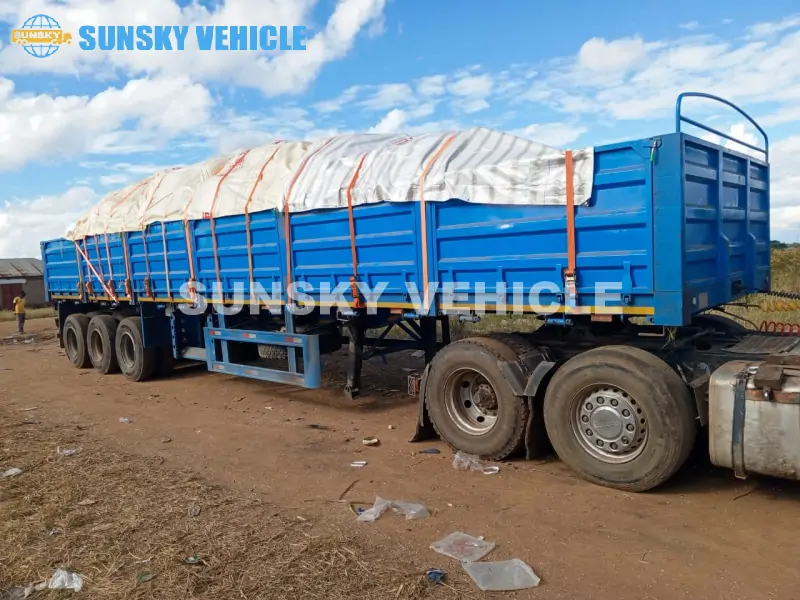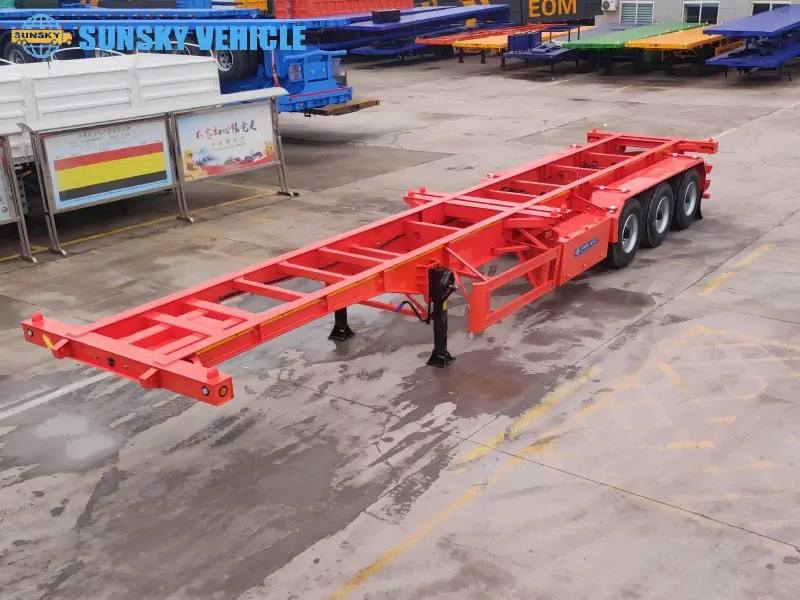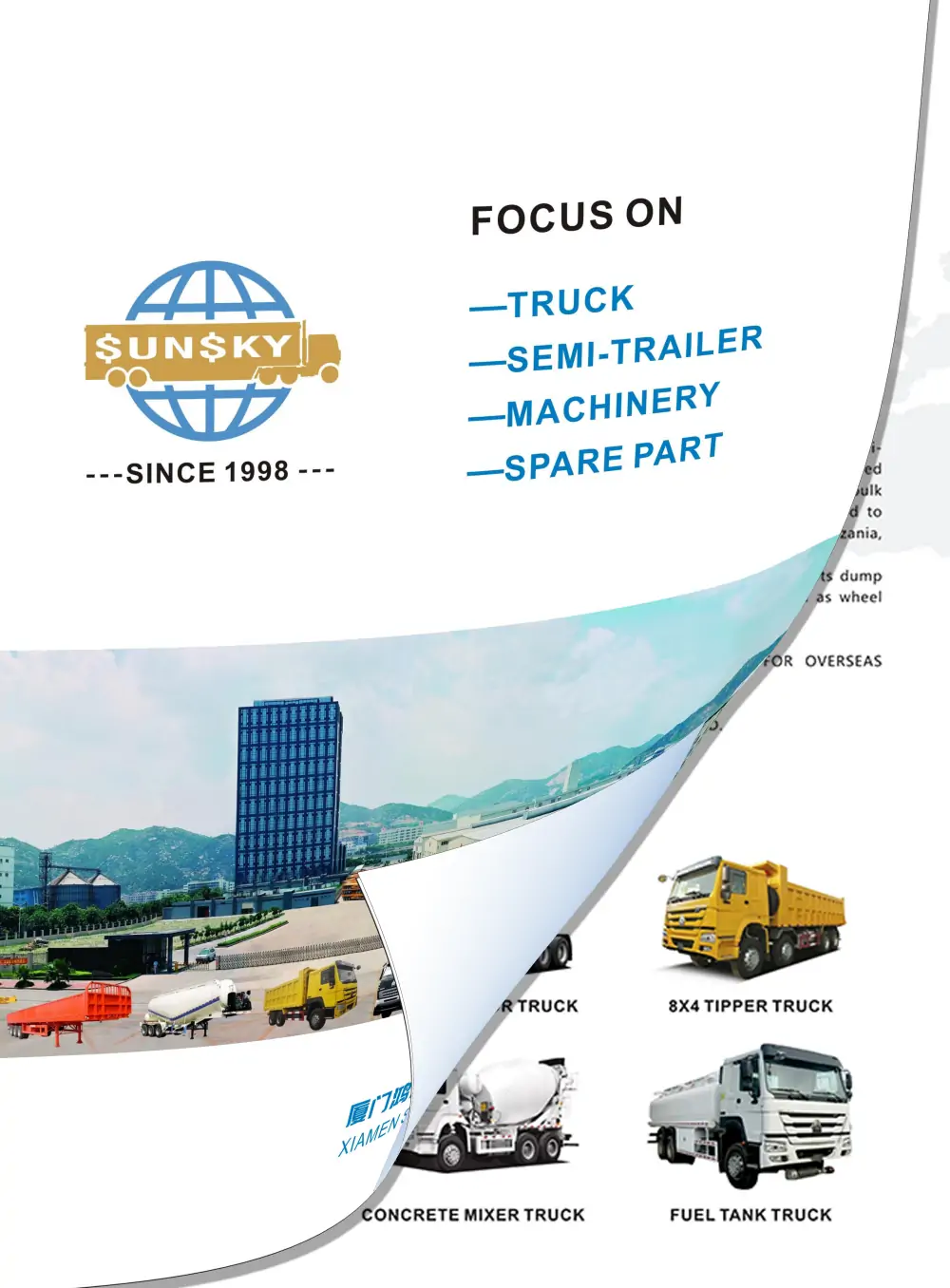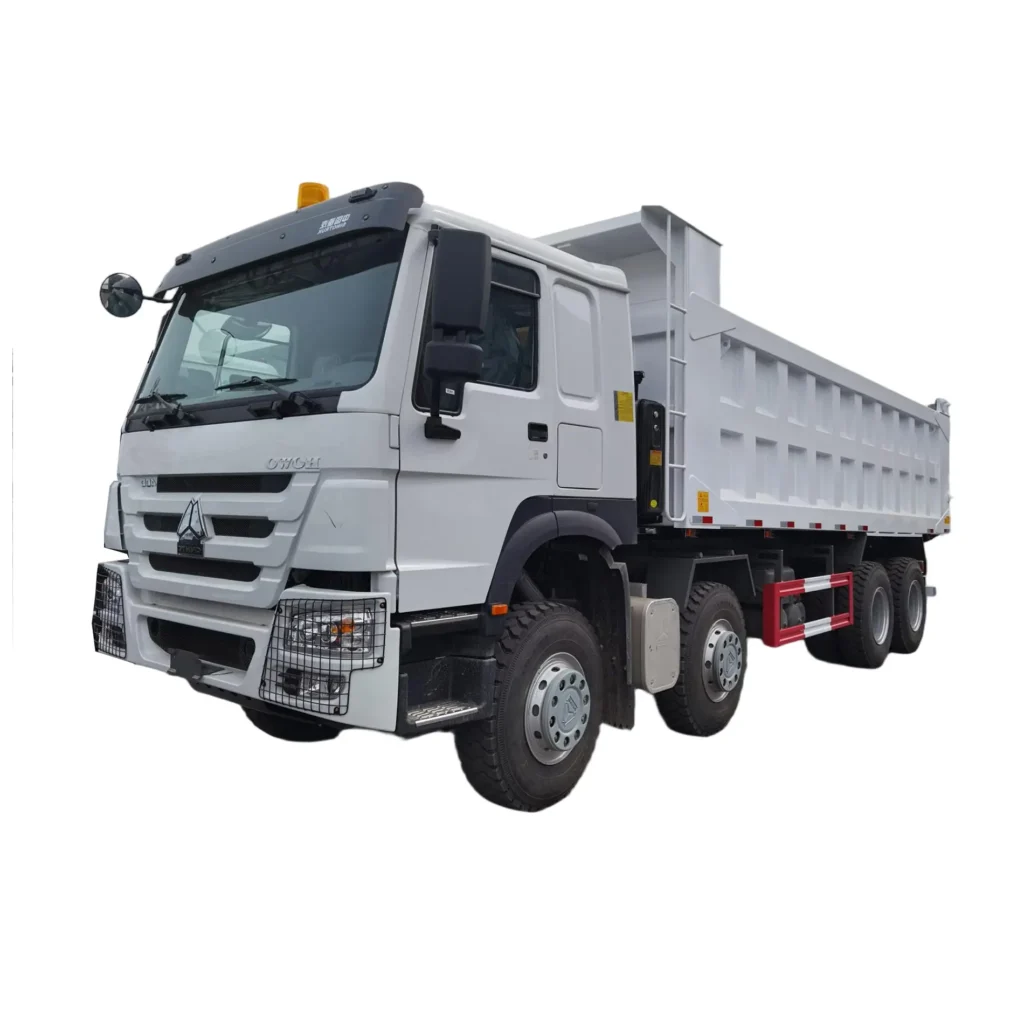
Dump truck
Explore our wide range of dump trucks, from light to heavy duty and mining. Our dump trucks feature a rugged body and reliable hydraulic systems to ensure fast and safe handling of bulk materials for any project.
What is a dump truck?
A dump truck, also widely known as a tipper truck, dumper, or haul truck, is a specialized commercial vehicle used for transporting loose material in bulk, such as sand, gravel, dirt, demolition debris, or asphalt. Its defining feature is an open-box bed that is hinged at the rear and equipped with powerful hydraulic rams to lift the front of the bed, allowing the material to be “dumped” or “tipped” out at the delivery site. Available in various configurations, from small models for light construction to massive off-road versions for mining, dump trucks are essential for efficiently moving large volumes of raw materials in industries like construction, mining, and landscaping.
Dump truck for sale
tipper truck application scenarios
Dump trucks, including dump pickups and flatbeds, are extremely versatile heavy-duty trucks that are used in many industries because of their flexible loading options.

Construction & Excavation: The most common use, hauling aggregates (sand, gravel), topsoil, concrete, asphalt, and demolition debris to and from construction sites for roads, buildings, and infrastructure projects.
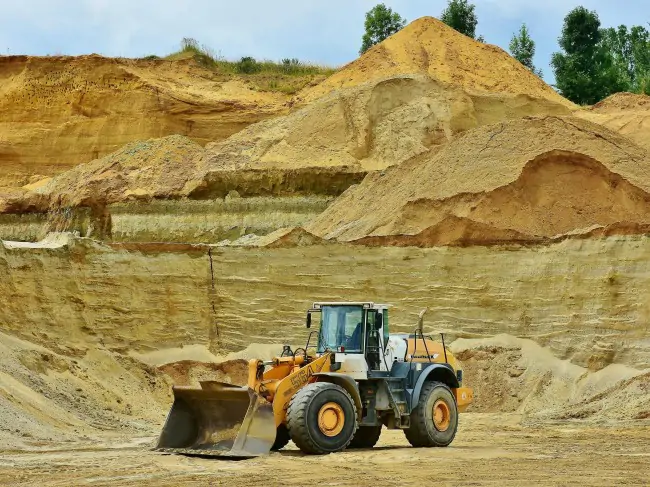
Mining & Quarrying: Transporting large volumes of ore, rock, overburden, and other excavated materials within mines and quarries. Often, specialized, larger off-road dump trucks are used here.
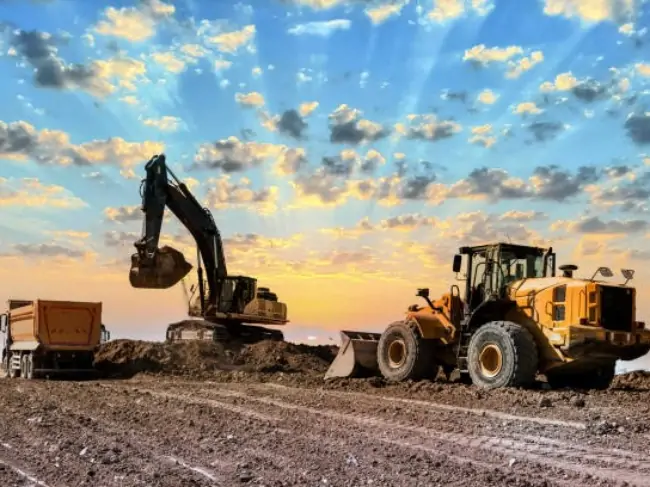
Waste Management: Used to transport construction and demolition waste (C&D waste) or other non-hazardous bulk solid waste to landfills or recycling facilities.

Landscaping & Earthmoving: Moving dirt, mulch, rocks, and other bulk landscaping materials for commercial and residential projects.

Road Maintenance: Delivering asphalt for paving, or salt and sand for de-icing roads during winter months.
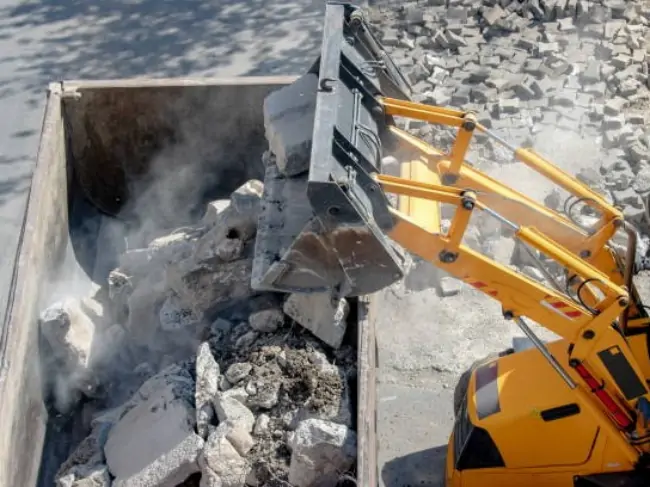
Utility & Infrastructure Projects: Transporting backfill material for trenching and pipe-laying operations, or moving excavated spoil.
Standard configuration
-
truck body length
-
12R22.5 Tires
-
LED light system
-
Q345 steel
-
surface paint process
-
Leaf spring suspension
-
condition of the chassis cab
Customizable options
-
truck body height
-
truck body design
-
LHD/RHD
-
payload
-
vehicle brand
-
accessory(fuel tank,water tank)
-
color
Looking for some new designs ?
tipper trucks detail design
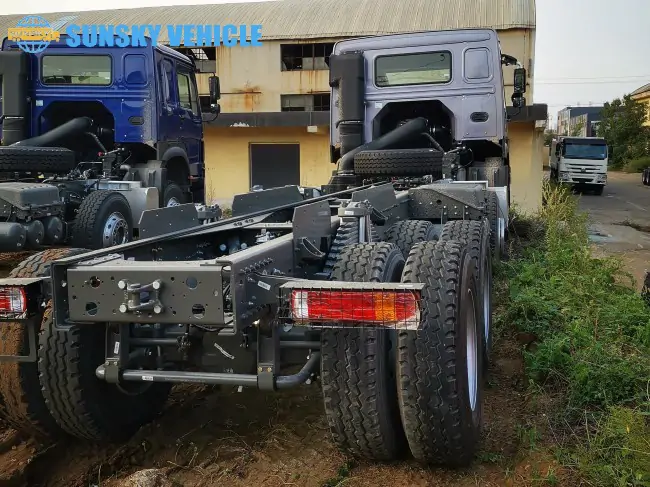
Heavy-duty dump truck chassis is the vehicle category code “3”. At present, major medium and heavy-duty automobile chassis manufacturers at home and abroad all produce light, medium and heavy-duty dump truck chassis.
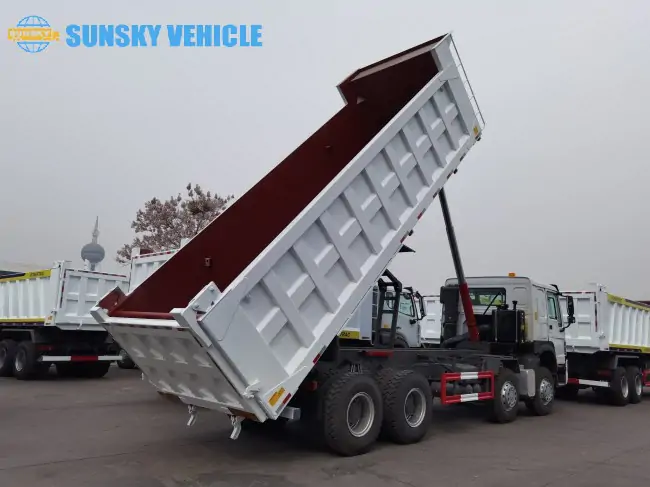
Hydraulic system lifting mechanism
There are two types of hydraulic systems: one is an open hydraulic system, that is, there is an oil storage device – oil tank in the hydraulic system; the other is a closed hydraulic system, that is, there is no other oil storage device – oil tank in the hydraulic system, but the oil is returned inside the cylinder.
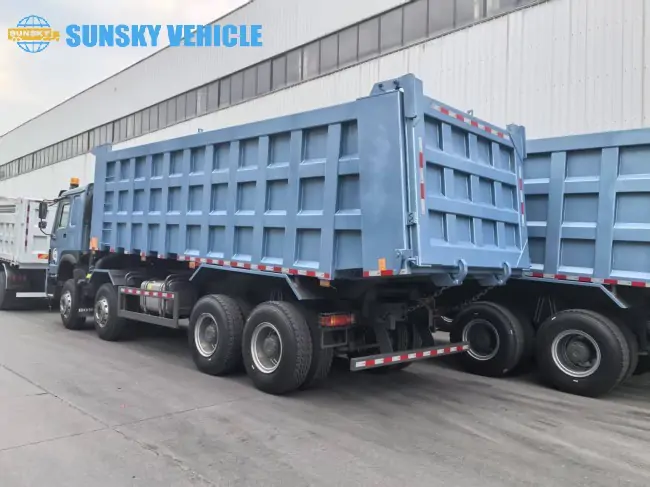
Rear guardrail locking mechanism and fender composition
The function of the rear rail plate locking mechanism is to realize the automatic opening and locking of the rear rail plate of the dump truck when opening and closing, thereby realizing automatic unloading.
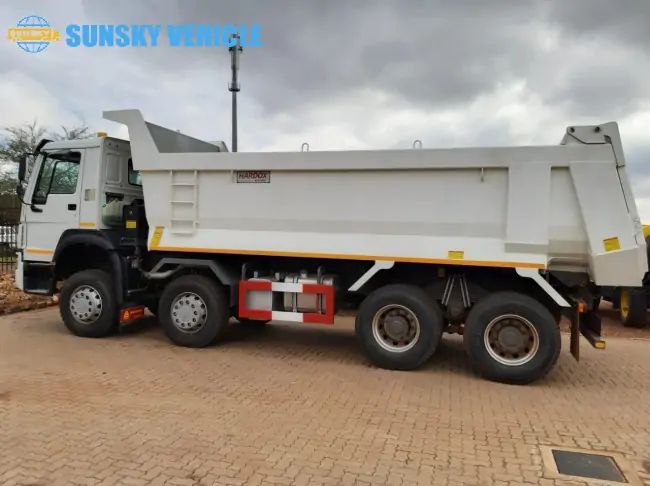
The carriage is a device for dump trucks to load goods. Heavy-duty automobile carriages are divided into: single-door, three-door, five-door, and dustpan type according to the structural form.
Single door: Only the rear partition can be opened and closed automatically.
Three doors: The left and right sides of the carriage can be opened and closed (when seriously overloaded, the goods can be allowed to leak from both sides of the carriage), and the rear of the carriage can be opened and closed automatically.
Five doors: Two doors on each side of the partition can be opened and closed, and the back of the partition can be opened and closed automatically.
Dustpan type: The rear end bottom plate is upward, mainly used to transport large pieces of goods such as ore.
Video of dump body trucks
4x2 tipper truck
HOHAN 400HP tipper truck
HOWO 371HP 6X4 dump truck
Used dump truck

The truck type you are looking for is not found
FAQ
What are the different types of dump trucks and their uses?
There are several types of dump trucks, each designed for specific applications and load capacities. The most common is the standard dump truck, often called a tipper truck, which has a truck chassis with an attached dump body. These are versatile for construction, landscaping, and general hauling. Transfer dump trucks consist of a standard dump truck pulling a separate trailer (transfer box) that can slide its loaded container into the truck’s main dump body, doubling capacity without exceeding length limits.
Semi-trailer end dump trucks are tractor-trailer combinations where the dump body is on the semi-trailer, ideal for large volumes on highways. Side dump trucks also use a semi-trailer but tip to the side, allowing faster unloading and greater stability on uneven ground. For extremely challenging terrains like mines, Articulated Dump Trucks (ADTs), or articulated haul trucks, offer excellent off-road mobility with a hinged chassis, while massive Off-Highway Rigid Dump Trucks are designed solely for heavy-duty, short-haul work within mines or quarries. Each haul truck type is optimized for different capacities, terrains, and material handling needs.
How does the hydraulic system on a dump truck operate for unloading?
The hydraulic system on a dump truck is fundamental to its operation, enabling the quick and efficient unloading of bulk materials. At its core is a hydraulic pump, which is typically powered by the truck’s engine via a Power Take-Off (PTO) unit. When the operator engages the dump function, this pump draws hydraulic fluid from a reservoir and forces it under high pressure through a series of hoses and valves to one or more hydraulic cylinders (often telescopic rams) located beneath the dump body.
As the hydraulic fluid is pushed into the cylinders, they extend, acting like powerful pistons. Because the dump body is hinged at the rear of the chassis, this extension lifts the front of the body, causing it to tilt upwards. Gravity then allows the loose material (sand, gravel, dirt, etc.) to slide out of the open tailgate. To lower the bed, the hydraulic pressure is released, allowing the fluid to return to the reservoir, and the weight of the dump body (sometimes assisted by gravity) brings it back down to its resting position. This robust hydraulic mechanism is what makes a tipper truck an incredibly efficient tool for material handling on job sites.
What are the key safety considerations when operating a tipper truck?
Operating a dump truck, or tipper truck, involves significant safety considerations due to the vehicle’s size, weight, and the nature of its unloading process. Firstly, site assessment and leveling are critical before dumping. The truck must be on firm, level ground to prevent rollovers when the bed is raised. Uneven terrain can shift the center of gravity dangerously. Secondly, clearance is paramount. Operators must be aware of overhead power lines, bridges, and other obstructions when raising the dump body and ensure adequate side clearance when maneuvering.
Thirdly, load distribution within the dump bed is vital. Unevenly distributed loads can cause instability during transit and especially during tipping. Fourthly, tailgate security is essential. Ensure the tailgate is properly latched before transit and fully unlatched before dumping to prevent accidental material spills or damage. Fifthly, blind spots are extensive around a haul truck. Operators must use mirrors, cameras, and spotters if available, especially when backing up or maneuvering in congested areas. Lastly, adhering to safe operating speeds, performing regular pre-trip inspections, and ensuring all hydraulic systems are functioning correctly are non-negotiable to prevent accidents and ensure the safe operation of any dump truck.
How does the body material of a dumper affect its performance and durability?
The body material of a dumper, or dump truck, significantly impacts its performance, durability, and ultimately, its payload capacity and operational lifespan. The most common materials are steel and aluminum. Steel dump bodies are renowned for their strength and durability. They are highly resistant to abrasion, impact, and wear from heavy, sharp, or corrosive materials like rocks, concrete, and demolition debris. This makes them ideal for demanding applications like mining, quarrying, and heavy construction, offering excellent longevity. However, steel is heavier, which can reduce the payload capacity.
Aluminum dump bodies, conversely, are prized for their lightweight properties. This reduced tare (empty) weight allows the tipper truck to carry a greater payload within legal weight limits, directly increasing hauling efficiency and potentially reducing fuel consumption. While generally not as resistant to abrasion and heavy impacts as steel, modern aluminum alloys are very strong and suitable for hauling lighter bulk materials like sand, gravel, asphalt, or grain. The choice between steel and aluminum for a haul truck’s dump body depends directly on the type of material being transported, the desired payload, and the operational environment, balancing durability with efficiency.
What are the maintenance requirements for a tipper truck's hydraulic system?
Maintaining a tipper truck’s (or dump truck’s) hydraulic system is critical for its safe and efficient operation, as this system is responsible for lifting and lowering the heavy dump body. Regular inspection of the hydraulic fluid is paramount: check levels and clarity (ensure it’s not milky or contaminated), and replace it according to manufacturer recommendations. Contaminated or low fluid can lead to pump failure and sluggish operation.
Secondly, routinely inspect all hydraulic hoses and fittings for any signs of leaks, cracks, bulges, or chafing. Leaking hoses can lead to pressure loss and potential system failure. Thirdly, inspect the hydraulic cylinders themselves for any signs of pitting, rust, or leaks around the seals. Damaged seals can reduce lifting power and require costly repairs. Fourthly, ensure the Power Take-Off (PTO) unit is engaging and disengaging smoothly and that its mounting bolts are secure. Lastly, all valves and filters within the hydraulic system should be checked and replaced periodically to prevent blockages and ensure clean fluid flow. Proactive and consistent maintenance of the hydraulic system is key to prolonging the life and ensuring the reliable operation of any dump truck.
Connect with us
Ready to partner? We’re convinced Sunsky Vehicle is your best choice! Reach out through the form or by phone.

*Our team will answer your inquiries within 24 hours.
*Your information will be kept strictly confidential.

